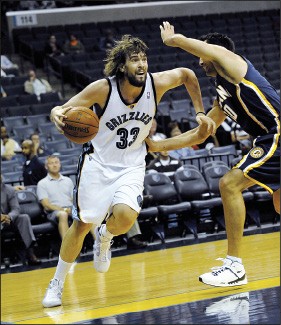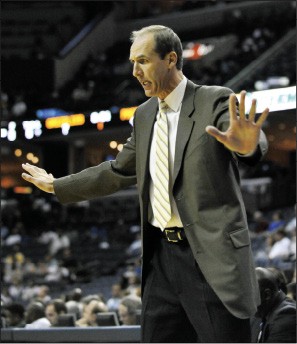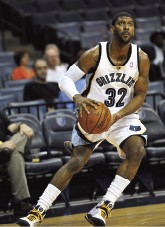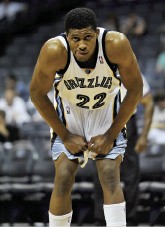A little more than a year ago, Grizzlies general manager Chris Wallace inherited a capped-out loser of a team built around a core duo of well-compensated and pushing-30 post-season underachievers: Pau Gasol and Mike Miller. It was a team coming off a dreadful 22-win season with a roster divided into veterans looking for a way out (Gasol, aging point guard Damon Stoudamire) and young players itching to take over (Rudy Gay, Kyle Lowry, eventual draftee Mike Conley).
With this mixed-message roster drifting listlessly last winter toward another lost campaign, Wallace decided the time for half-measures was over, jettisoning Gasol for four prospects/draft picks and cap room in a wildly controversial move and completing the demolition this summer by packaging Miller in a bold draft-day trade to net blue-chip rookie guard O.J. Mayo.
Wallace and owner Michael Heisley have gone “all in” on a future that fans — actual or potential — might only glimpse this year. Heisley has been specific about the developmental arc to come, dubbing it a “three-year plan.” For the first time in years, the Grizzlies enter a season without Gasol and Miller as the foundation of the roster. Instead, this year’s model will belong to a different pairing: Gay and Mayo, a tandem with more raw talent and grit than any core duo the franchise has assembled.
Reaping the fruits will take time, though. The NBA is a man’s league, and young teams tend to lose — in bunches. And the 2008-’09 baby Grizzlies are some kind of young. With an average age of 24.3, the Grizzlies will boast the league’s third-youngest roster, after the Golden State Warriors and Portland Trailblazers. But even that comparison is misleading. Both the Warriors and Blazers have veteran players in the rotation and raw kids riding the pine. The Grizzlies are opposite. Over-30s Antoine Walker and Greg Buckner are unlikely to see much time. The team’s prospective nine-man rotation — Conley, age 21, Lowry, 22, Mayo, 20, Gay, 22, Quinton Ross, 27, Hakim Warrick, 26, Darrell Arthur, 20, Darko Milicic, 23, and Marc Gasol, 23 — is, by far, the league’s youngest. The Grizzlies will open the season with two rookie starters — Mayo and Gasol — and could well add a third in Arthur at some point this season.
It’s a group bursting with athleticism and upside, but there are also important qualities this assemblage lacks: experience, established track record, a balance of skills. All of the team’s guards are used to handling the ball, not playing without it. None of the team’s power forwards are proven, well, power players. There is clearly work to be done. A final product won’t take the floor until at least the fall of next year.
And inexperience isn’t just an issue on the court. Entering only his second full season as a head coach, Marc Iavaroni is tied with Sacramento’s Reggie Theus as the league’s fourth-least-experienced head coach. After a rocky first season plagued by a dismal record in close games and damaging playing-time decisions (sticking with a wildly ineffective Casey Jacobsen until Heisley intervened), Iavaroni has as much to prove as his players.
Change You Can (Hopefully) Believe In
This year’s Grizzlies roster contains only six (of 14) players who finished last season with the team. But the eight new faces are only the start to what will be a very different basketball team everywhere, except in the standings.
For years, the Grizzlies have been built around the combination of Pau Gasol’s post play and a deep core of three-point shooters. With the departures of Gasol, Miller, and Juan Carlos Navarro, this year’s team can’t depend on either of those offensive elements. Instead, Iavaroni will have to fashion his talent around a different set of offensive strategies, ones that will likely replace post play and three-pointers with more fastbreaks, more free throws, and more mid-range shooting.
Gay and Mayo will be the team’s primary scorers, and both seem capable of being Top 10 scorers in the league someday. An electric athlete with a surprisingly deft shooting stroke and improving ball-handling ability, Gay exploded in his second season, becoming the first second-year player since superstars Lebron James, Dwyane Wade, and Carmelo Anthony to top 20 points per game. He also showed signs of becoming something this franchise has never had: a go-to scorer with not only the ability but the desire to take big shots at the end of games.
 by Larry Kuzniewski
by Larry Kuzniewski
Meet the new Gasol: Pau’s burly brother Marc
Mayo, who has been a hoops mini-legend since junior high, is already the team’s best pure shooter, but he may not be quite the player fans are expecting. Rather than the highlight-reel athlete Mayo’s Q-rating suggests, the rookie guard instead has looked more like a solid assassin: a player whose unspectacular athleticism could be overcome by deft shooting, tough-nosed defense, and a preternatural court presence. But as a rookie dependant on outside shooting for much of his offense, Mayo will have games this season where he rains jumpers from all over the court. He’ll have others when his shot isn’t falling, and he’ll put up some ugly box-score lines.
For the Grizzlies, one challenge will be maximizing Gay’s and Mayo’s offensive skills without devolving into too much one-on-one play. This means putting the ball in the hands of primary playmakers Conley and the burlier, woollier (if you can believe it), younger Gasol, who looks like he can replace his older brother’s passing ability if not his scoring. And it means fostering the kind of chemistry and unselfishness than can help get secondary players the kind of shots they need to succeed.
The Grizzlies will try to utilize their superior team speed — especially in the form of point guards Conley and Lowry — to maximize transition opportunities and to attack off the dribble in halfcourt sets, freeing up the team’s trio of mid-range-shooting frontcourt players — Gasol, Warrick, and Arthur — for open looks off pick-and-pop plays and kickouts.
There’s been a lot of hand-wringing lately about the team’s lack of three-point shooters, both from within the organization and among the media, but despite the presence of Miller and Navarro, one of the Grizzlies’ problems last season (albeit a minor one, all things considered) was the team’s over-reliance on three-point shooting. Last year, the Grizzlies were fourth in the league in three-point attempts per game but only 22nd in three-point percentage.
The lack of proven three-point threats will be less of a problem this season if the team has the good sense to dial back its attempts in favor of more drives to the hoop. In this sense, the preseason seems to be a pretty good indicator of shifting strategy. After averaging 21.7 threes per game last season, that number was down to 15.9 this preseason, while free-throw attempts increased from 25.6 to 30.5. (This change will not work out well, however, if the team can’t improve on its dreadful 66 percent preseason free-throw shooting.)
Another thing that should help the Grizzlies offense this season is a reduction in turnovers, something that should happen naturally after point guards Conley and Lowry played their first full NBA seasons a year ago.
 by Larry Kuzniewski
by Larry Kuzniewski
Memphis Grizzlies coach Marc Iavaroni
Finally Getting Defensive
After finishing 21st in the league in offensive efficiency last season with a full season of Miller and half-season of Pau Gasol, the Grizzlies would do well to match that production despite the change in players and strategies.
That means if this year’s team is to improve, the heavy lifting will most likely come on the defensive end, where last year’s team was 28th (third from the bottom). Ordinarily, getting younger is not a recipe for defensive improvement, but this year’s Grizzlies should be able to buck that bit of conventional wisdom through a combination of increased emphasis and better personnel.
After watching the Boston Celtics march to a title with a league-best defense spurred, in part, by the hire of “defensive coordinator” assistant Tom Thibodeau, Heisley decided he wanted a defensive specialist on his coaching staff too. This led to the hire of longtime college and NBA coach Kevin O’Neill to focus on reinventing the team’s defense with an approach that’s both more traditional and more aggressive.
In this transformation, the team should be helped by a massive increase in quickness and defensive mentality on the perimeter. Last season, since-departed slow-footed perimeter defenders Miller, Navarro, Casey Jacobsen, and Stoudamire accounted for nearly 30 percent of the team’s total minutes played. This season most of those minutes will be soaked up by Conley, Mayo, and off-season free-agent find Quinton Ross, which should result in a massive defensive improvement along the perimeter, forcing more turnovers and reducing the number of times opposing guards break down the Grizzlies’ “D.” Conley is stronger than he was his rookie season; Mayo has been surprisingly solid on the defensive end; and Ross is a quick, long-limbed defender with a track record of ably guarding the league’s top scorers. If Gay can improve his effort on that end, the Grizzlies have a chance to be pretty dynamic defensively along the perimeter.
On the interior, the team is likely to have bigger problems: Power forwards Hakim Warrick and Darrell Arthur are both undersized for the position and are likely to get punished some nights by bigger, stronger opponents. At center, Marc Gasol has proven to be quite unlike his older sibling in his toughness and willingness to engage in physical play, but his lack of foot speed will make him vulnerable to big men who are able to attack off the dribble and make it difficult for him to rebound out of his immediate area.
The team’s best frontcourt defender and rebounder is Darko Milicic, who has had substantial problems staying healthy and staying focused throughout his young career. The Grizzlies will ask a slimmed-down Milicic to play both frontcourt positions and guard the league’s best post scorers. It might be asking too much, but the team doesn’t have better options. Regardless, the team’s interior defense is unlikely to be worse than it was a year ago.
 by Larry Kuzniewski
by Larry Kuzniewski
O.J. Mayo
With more agile, aggressive defenders along the perimeter and a couple of live bodies in the middle, the Grizzlies have a chance to provide the kind of forceful, opportunistic defense promised a year ago. Last season, the team was 17th in blocks per game and a pitiful 28th in steals, combining for 10.8 a game. This preseason, the combined blocks-plus-steals average has been 14. If that carries over into the regular season, it will feed into more transition opportunities.
But Will Anybody Care?
That’s the biggest question for a team that has been losing fans the past three seasons. With a bad economy and a tight lease guarding against the ever-present fears of relocation and with a lowered payroll mitigating financial losses despite falling ticket sales, the silver lining is that the team seems to have time to let this current crop of baby Grizzlies grow together and win back fans. But it won’t be easy.
It would be helpful to think of this year’s Grizzlies as an unusually promising expansion team, but after three straight playoff sweeps followed by two straight lost seasons, a dwindling fan base seems to have developed a “call me when you’re good again” attitude. It doesn’t help that so many potential fans are more interested in the exploits of the minor-league team sharing the building, one all but guaranteed on-court success in a noncompetitive system.
The Grizzlies, on the other hand, can’t be expected to win much this season. But, for starters, how about a more reachable goal: an entire season of purposeful basketball? The past two seasons have been derailed by, first, an in-season change to a lame-duck interim coach (Tony Barone) and then a sea-change trade of a veteran star (Pau Gasol). In both cases, the presence of “franchise savior” prospects in the looming draft rapidly turned losing seasons into summer-focused holding patterns. No more.
At least two of those three issues are unlikely to pop up this season: There’s no veteran star to jettison, and next summer’s draft doesn’t seem to boast any quick fixes. As to the coaching situation: Who knows?
If there’s a model for this year’s Grizzlies, it isn’t the past two seasons but the 2002-’03 squad, in which Hubie Brown took over for incumbent coach Sidney Lowe and guided a young core through a season-long improvement. That team only won 28 games, but it got better, was fun to watch, and set the stage for a massive improvement the following season. That’s a realistic model the 2008-’09 Grizzlies would like to follow but with players who have even more upside. The looming question would be: Is Marc Iavaroni the Hubie Brown of this scenario or the Sidney Lowe?
For more Grizzlies coverage now and throughout the season, see Chris Herrington’s blog “Beyond the Arc” at
memphisflyer.com/grizblog.
 by Larry Kuzniewski
by Larry Kuzniewski
Rudy Gay
Coachspeak
Grizzlies coach Marc Iavaroni weighs in:
On rookie surprise Darrell Arthur:
“He had a very up-and-down mini-camp and summer league, so I didn’t know what to expect from him. But I do know he was working very hard. The kid has shown a lot of spunk and ability. I think he should definitely be in the rotation.”
On shaky offensive execution in the preseason:
“Even though our primary scorers — O.J. [Mayo], Rudy [Gay] and Marc Gasol, and sometimes Hak[im Warrick] — are going to have some things called for them, they’re going to have to understand: Even though it’s your play, it might not always be your shot. We’ve got to be better passers. We’ve got to do all the little things that add up to sharp execution, and if the shot goes in, great. If the shot doesn’t go in, either we get guys to shoot better, or we have to get better shooters.”
On developing on-court chemistry:
“I think it’s a process. You’ve got a known scorer in Rudy and a known scorer in O.J., and it’s a process for them to understand that there are only so many shots in a game.”
On improved perimeter defense:
“I think we probably have more juice there and more defensive orientation. Look at Quinton Ross. Look at Greg Buckner. Rudy’s capable. And, frankly, O.J. should be a better defender than Mike Miller. But he’s going through a lot of growing pains too. He’s a rookie. He’s going to make mistakes.”
On Rudy Gay’s development:
“He’s been pushing himself to be more than just the leading scorer. He has to be the leading man. Leading men have to do more than just look good. He’s got star potential, but he will be judged on how well others play with him, and that’s a lot of responsibility for a young kid who’s not used to being in that role and who’s now with a team that’s counting on him so heavily. It’s not going to happen overnight. Those are some big steps to take.”
On finding the right role for Darko Milicic:
“I’ve got to more narrowly define his role and get him feeling good about kicking butt inside and not worry about whether it’s a good shot or a bad shot. We can’t leave him on an island with the ball at 18 feet. I think that’s where he gets himself into trouble.”
On a potentially rough start:
“What will define us is our approach. If we’re going to come off the court every night having said we worked harder than our opponent; we did not back down, then I think we’re going to be building something. But if we’re going to start making excuses, start saying we’re flat, start saying we’re young, start saying we’re new to one another, then we’ll be building in failure. And that’s something that we cannot accept.”
To read the complete interview with Marc Iavaroni, see “Beyond the Arc” at memphisflyer.com/grizblog.
Seven Deadly Predictions
Going on the record about this year’s Grizzlies.
1. The Grizzlies will finish last in average home attendance. And it may not even be close. Last season, the Grizzlies finished 29th of 30 NBA teams, outdrawing the Indiana Pacers by about 500 spectators a game. This season, with the Pacers having jettisoned more of the players who alienated a once-strong fan base, the New Orleans Hornets a legit title contender, and the former Seattle Sonics embarking on their first season as the Oklahoma City Thunder, three of last season’s other bottom-five draws should be in line for a significant bump. With the economy in trouble, things will be bad in New Jersey, Charlotte, Sacramento, Milwaukee, and Minnesota, as well. But look for the Grizzlies to be four-digits worse than anyone else this season.
2. O.J. Mayo will finish third in an unusually strong Rookie of the Year race. Mayo will trail only Miami’s Michael Beasley among rookie scorers at just under 18 points a game, but both will come up short to Portland’s Greg Oden in the ROY race. Marc Gasol, who will start all season, will be a second-team all-rookie selection, while fellow rookie Darrell Arthur, who will end the season as a starter, will just miss all-rookie honors.
3. Rudy Gay will be a Top 15 scorer but not an all-star. After finishing 26th in scoring average last season at 20.1, Gay will push his scoring average closer to 23 per game, knocking on the door of Top 10 status. He’ll warrant all-star consideration in a conference lacking great small forwards, but the team’s dismal win-loss record will keep him out — this year.
4. Mike Conley will be wobbly early but will establish himself and get some Most Improved Player votes. Few players in the league are in as difficult a spot as Conley: trying to establish himself as an NBA point guard at age 21 with two other perimeter teammates in Gay and Mayo hungry for the ball. Conley will feel his way for a couple of months before taking off, establishing himself as one the league’s best young point guards heading into next summer.
5. A trade will be made — but not a big one. Behind Conley, Kyle Lowry will bristle at his bench role while Javaris Crittenton and Marko Jaric will struggle to find minutes. Something’s got to give. Look for Lowry to rehab his trade value after a bad pre-season and be shipped to a point-guard-needy team by mid-season.
6. Marc Iavaroni will survive the season; Antoine Walker will not. A bad economy and declining revenues will make Grizzlies owner Michael Heisley more cautious about buying out one coach to hire another, giving Iavaroni a longer leash than he might otherwise have, and the team will show enough improvement for Iavaroni to last the season. Despite a reluctance to take less money in a buyout, unneeded vet Walker will find some way to exit Beale Street Blue before the season ends.
7. The Grizzlies will finish 28-54. After a rough early start, the young guys will gel and improve enough for the Grizzlies to play competitive basketball down the stretch, setting the stage for a bigger leap forward next season. — CH
 by Larry Kuzniewski
by Larry Kuzniewski  by Larry Kuzniewski
by Larry Kuzniewski  by Larry Kuzniewski
by Larry Kuzniewski  by Larry Kuzniewski
by Larry Kuzniewski